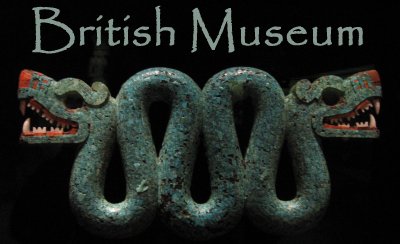
 |
The British Museum should be counted among the wonders of the world. Enormous almost beyond imagining, the small details—informational panels, identifying captions, docent expertise—are what really make it a fabulous experience. You don't just see its famous (and lesser-known) objects, but it's easy to learn more than you ever expected about the societies and cultures that created them.
| John Oliver (on the Daily Show) kids that British museums in general are "active crime scenes," due to their collections being largely "appropriated" from less-developed cultures. But the other side of this argument is that these objects are, definitely, very well taken care of, preserved in physical and educational conditions much superior to what they probably would have enjoyed in their native lands. This informative page, in the section "contested objects from the collection," explains how the sculptures came to the Museum, describes discussions with the Greek government about them, and links to an official statement from the Museum's trustees. |
To read about my four visits to the Museum soon after they occurred, check these blog posts: visit 1 • visit 2 • visit 3. You would think that 4 visits would be enough to see everything in the Museum, and I believe I visited every gallery at least once. But as to seeing everything—HA!—it's just not possible!
Larger versions of these photos, plus many, many more, are in these Flickr sets: Greek, Roman, etc. (includes photos of the Museum in general, and of some contemporary artworks) • Other exhibits (Egypt, Middle East, Africa, Asia, America, themed exhibits). (I visited the European galleries but didn't take many good pictures there; one is in the "other" Flickr set.)
For purposes of organization on this page, I've divided up this very small selection of British Museum photos on a geographical basis, depending upon the cultures creating the artifacts (be aware that I had to guess about some objects' classifications, but I believe I remembered which galleries most of them are from):
Greece/Rome • Egypt • Middle East • Americas • Asia
The British Museum website lets you search their online galleries and see, and learn more about, some of the artifacts. They've also partnered with Google's Arts and Culture project to offer virtual tours. And there's also a venture with Google StreetView that allows exploration of the Museum. When I remembered the room numbers for objects shown here, I have included them; but be aware that they might have been moved since my visits.
The highlight of the Greco-Roman exhibits, and perhaps of the Museum as a whole, are the sculptures known as the Elgin Marbles, the Parthenon sculptures referred to above. Here are just a few photos of these amazing works of art, which I had read about for years and was so happy finally to get to see. The different coloration in the photos is a result of Henry using different settings on his more sophisticated camera.
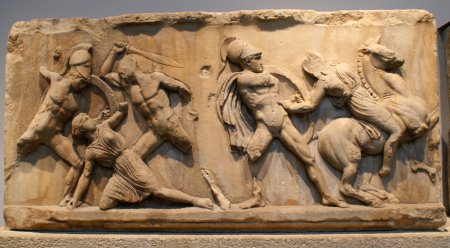 |
 |
 |
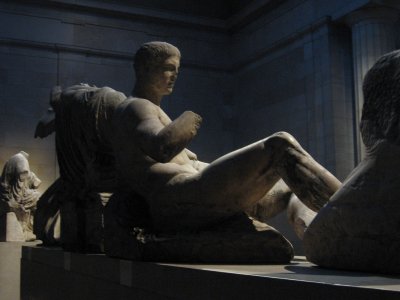 |
The gallery with the Elgin Marbles is one of the most popular sections of the museum, but it's spacious enough not to be over-crowded; at least it wasn't while we were there. The photo on the left shows the section of the galleries featuring the reliefs. On the right is another Greek statue from a nearby gallery:
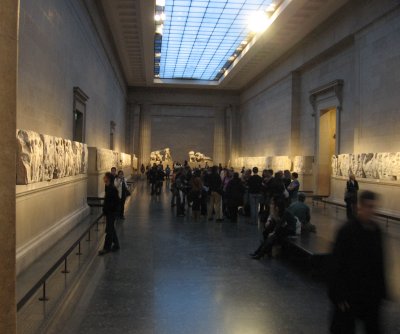 |
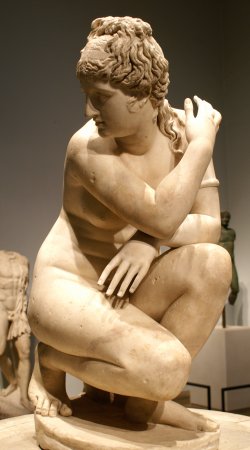 |
I have always loved Greek red-figure pottery, and took several photos of the Museum's many pieces of it. Here's a sample:
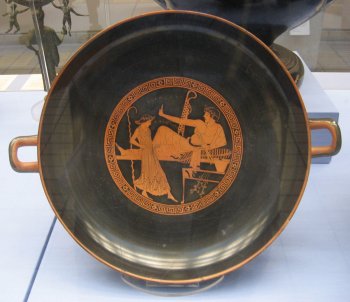 |
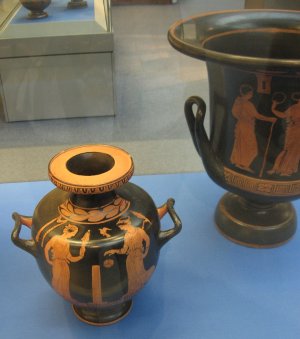 |
I'm not completely sure about the origins of these two charming pieces, but in the blog post where I featured the mug, I thought that it was Etruscan. And the acrobat—on a crocodile!—seems to be Roman, based on other photos taken in the same sequence. However, with such lovely works of art it doesn't really matter where they're from, does it?
 |
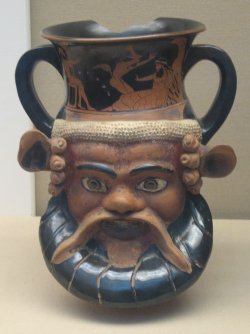 |
The Egyptian galleries, at least those containing the large sculptures from that civilization, are among the most impressive spaces in the Museum. Here is a panoramic shot of the gallery, and one of its most impressive pieces (and one of the largest in the whole Museum):
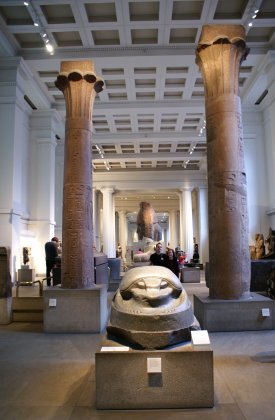 |
 |
The Egyptians excelled at more intimate sculpture as well. Like these examples of animal likenesses:
 |
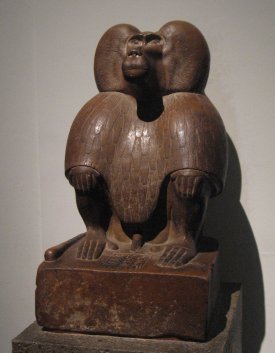 |
But of course one of the most famous, and most goose-bump-inducing, items in the Egyptian area is the Rosetta Stone. I'm so glad Henry was more patient than I was and waited until there was a lull in the almost constant press of visitors looking at its exhibit case, so he was able to get this shot without reflections of other tourists.

On my first visit to the Museum, with Hal, we decided to drop in on a free docent-led tour that was starting up at the right time for us. It happened to be covering Assyrian bas-reliefs, which I knew nothing about and wasn't particularly interested in, but the experience led me to formulate a rule about London museums: join up with any tour that goes by, even if it's about something you don't think you care about. Before it's over, you will care, and will also know so much more about a subject that previously wasn't of interest—it's practically magic!
We were so wrapped up in the guide's talk, we didn't take any pictures on that visit, but when I went back later, I reviewed what she had told us and snapped a few shots, including the one on the left, showing a common theme, the "tree of life." When Henry was wandering around the galleries, he took the one on the right, looking down the hall at the impressive Assyrian gates. Just past them is the gallery where the bas-reliefs are. I can't remember if my tree-of-life photo was taken in Room 7 or 9, but all of the displays and artifacts are so beautiful!
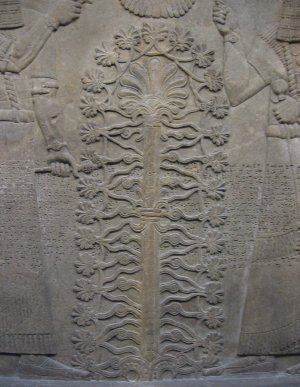 |
 |
On subsequent visits, I saw more fascinating Middle Eastern objects, and caught up with another great tour. This one covered just two rooms in the Mesopotamian galleries, but took almost an hour! Needless to say, I felt rather expert afterwards! Here are a couple of objects that the tour highlighted (I was so impressed with these artifacts that the kids picked up on it and gave me a reproduction of the game on the right for Christmas). Both were in Room 56 on this visit.
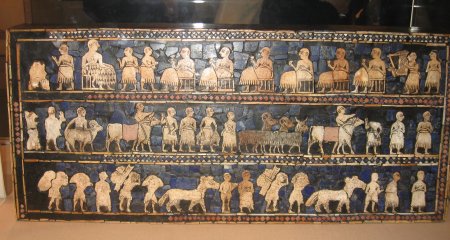 |
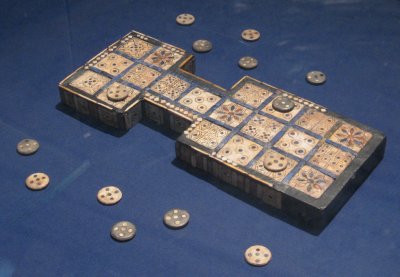 |
And here is a photo of objects had led me to that gallery in the first place—early cuneiform writing, some of the earliest written work ever produced. More goosebumps on the way, and aren't they lovely?
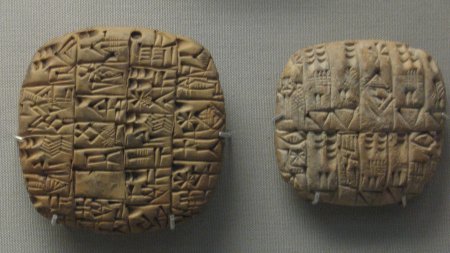
These galleries don't contain as many objects as those featuring other cultures, but what they have is pretty stunning. In addition to the turquoise snake mosaic/sculpture used as the headline graphic for this page, here are a couple more examples of New World craftsmanship. The relief is Mayan, but I'm not sure what culture produced the impressive snake sculpture:
 |
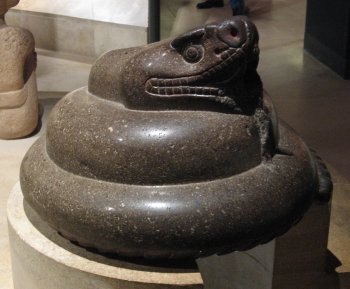 |
There were thousands of fabulous Asian artifacts in galleries dealing with Japan, Korea, China, India, and other cultures. So many, in fact, that it was difficult to take good pictures of individual objects. Here are two of my favorites, a Hindu goddess sculpture and a Chinese plate in mother-of-pearl. There are some more examples in the Flickr set:
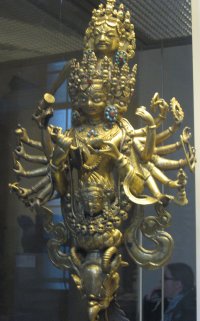 |
 |
In addition to the exhibits within it, the space of the Museum itself is a wonderful experience. Especially its wonderful enclosed Great Court.
Anna Quindlen describes it this way in Imagined London:
| "Perhaps as well as any other great London institution the museum plays with the idea of how past and present conjoin. The building itself does the trick, by combining a square and stodgy classical Greek temple facade with a glass-and-steel skylit roof over the great court. The transparent roof went in in 2000 and is an absolutely magical marriage of technology, beauty, and function." |
You can get an idea of what it's like from these photos. The one on the left I took from a tiny window on the next level up, looking down at a section of the Court. On the right you can see the window, as I took that picture down on the main floor looking up at it. That picture was taken after dark late one November afternoon. The Court's roof is a great skylight, and so normally, during daylight hours, it's as bright as it appears on the left:
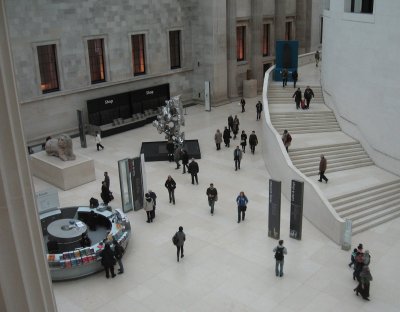 |
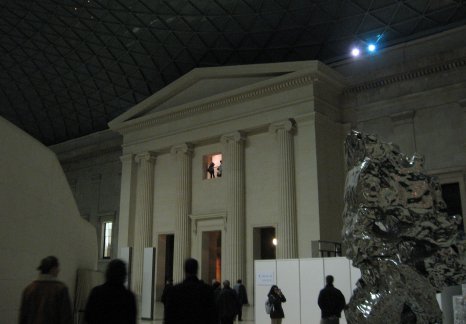 |
You may notice an unusual chrome sculpture in these photos. I really liked it. Here's a closer look at it, along with another section of the Court, and part of the Court Café. The large cylindrical structure in the middle houses offices, the reading room and special (non-free) exhibits as well as the wonderful gift shop on the ground level (where I bought almost all my 2008 Christmas presents!). In both of these photos you can see the immense skylight that encloses the space.
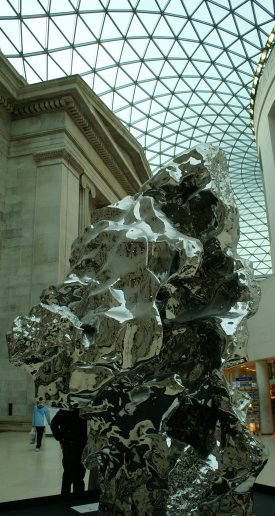 |
 |
Remember, this is just a teaser for my Flickr sets of British Museum photos, which contain 43 and 64 photos, respectively: Greek, Roman, etc. • Other exhibits
 |
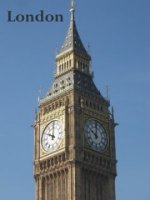 |
 |
Back to Dream Season home • Back to London home • Back to Museums home